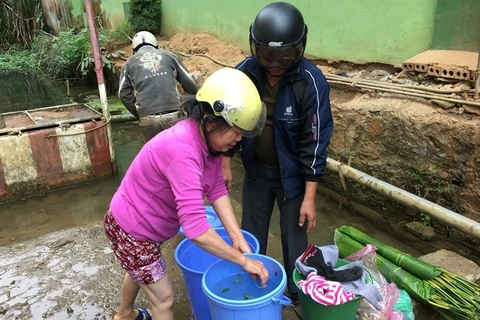Hanoi (VNS/VNA) - Nearly 90 percent of Vietnam's urban sewage is discharged untreated directly into its rivers and streams, according to a report by the Ministry of Construction.
The report also revealed alarming figures for the Vietnam’s two biggest cities – Hanoi and Ho Chi Minh City – regarding the handling of household sewage from millions of residents.
The capital city currently has six wastewater treatment plants. They include the Kim Lien plant with a capacity of 3,700cu.m per day, Truc Bach with 2,300cu.m, Bay Mau with 13,300cu.m, Bac Thang Long-Van Tri with 42,000cu.m and the largest one, Yen So, is able to process about 200,000cu.m of wastewater a day.
The plants, however, only managed to filter 22 percent of the total sewage discharged every day in the city, while the remaining 78 percent went straight from houses and restaurants to the environment.
The Hanoi People’s Committee said in its own report that the construction of new wastewater treatment plants was seriously behind schedule.
It also admitted difficulties in realising the Master Planning on Drainage in Hanoi by 2030. According to the master planning, which was signed in 2013, up to 90 percent of the city’s population would have their sewage collected and treated by 2030 and the rate was due to reach 100 percent by 2050.
Capital shortage was the main concern of the city authorities. Several priority projects were still on paper, said the Hanoi People’s Committee, as building a sewage system required a tremendous sum of money from the city’s already strained budget. Meanwhile, there were certain obstacles to call for funding from the private sector.
In the south, HCM City had around 21 percent of urban sewage water treated – a similar percentage to Hanoi’s.
There were three wastewater plants currently running in the city with total capacity reaching 302,000 cubic metres – equal to just a fifth of the sewage discharged across the city every day, which was estimated at 1.57 million cubic metres.
They were Binh Hung plant capable of handling 141,000cu.m, Binh Hung Hoa with 30,000 cu.m and Tham Luong-Ben Cat with 131,000cu.m.
The city was supposed to build seven sewage treatment plants according to a city drainage plan between 2016 and 2020.
When those new plants are completed and start operating, up to 1.4 million cu.m will be filtered daily, accounting for over 90 percent of the total city’s discharged wastewater.
That scenario, however, was not likely to happen soon as all seven plant projects were still calling for investors.
Director of the Construction Ministry’s Department of Science & Technology and Environment Vu Ngoc Anh said that there were 43 urban wastewater treatment plants nationwide with a total capacity of over 926,000cu.m per day.
“The issue lies in how to thoroughly connect the sewer system to collect and handle sewage. This is why the (national) treatment rate is so low, at around 13 percent,” he told the Thanh Nien newspaper.
Another report on Vietnam’s urban sewage management by the World Bank agreed with such a low number, saying that only 10 percent of the country’s total sewage actually went through a treatment plant.
The country was thirsty for investment – estimated at about 8.3 billion USD– to build drainage infrastructure for 36 million people living in cities, according to the World Bank’s report.
Head of the Institute of Environmental Science and Engineering, Dr Nguyen Viet Anh, admitted that the biggest challenge to Vietnam’s urban drainage was how to connect the household sewers to the citywide network.
“Most of the drainage projects funded by ODA (official development assistance) did not cover that (sewer linkages). And after the project was completed, it was very hard for the authorities or the communities to do the connection work,” Anh said./.






















